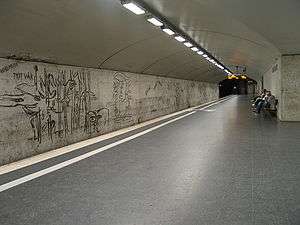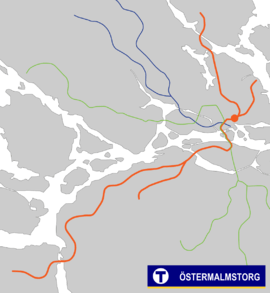Östermalmstorg metro station
| Stockholm metro station | ||||||||||||||||
 | ||||||||||||||||
| Coordinates | 59°20′05″N 18°04′26″E / 59.33472°N 18.07389°ECoordinates: 59°20′05″N 18°04′26″E / 59.33472°N 18.07389°E | |||||||||||||||
| Owned by | Storstockholms Lokaltrafik | |||||||||||||||
| Tracks | 2 | |||||||||||||||
| Construction | ||||||||||||||||
| Depth | 38 metres (125 ft) | |||||||||||||||
| History | ||||||||||||||||
| Opened | 16 May 1965 | |||||||||||||||
| Services | ||||||||||||||||
| ||||||||||||||||
| Location | ||||||||||||||||
 | ||||||||||||||||
Östermalmstorg metro station is station on the red line of the Stockholm metro, located in the district of Östermalm. The station was opened on 16 May 1965 as the 59th station in the Stockholm system. The platform is approximately 38 metres (125 ft) below the surface. It is located in the city center, making it one of the most-used stations in the system, with approximately 32,000 people passing through the station on an average workday.[1]
The station was built by the cut-and-cover method and formed the first part of the extension of the red line north of T-Centralen. Nearby stations include Stadion (T14) and Karlaplan. Stockholm Central Station is about 1 kilometre (0.62 mi) away.
The station has two main accessible exits, one by Östermalmstorg and one by Stureplan. The major artwork of the subway station was created by Siri Derkert and symbolises women’s rights, world peace, and the green movement. It was designed to function as a shelter in the event of nuclear war.
References
- ↑ "2006 Report on the Stockholm Metro" (PDF). (952 kB, in Swedish)